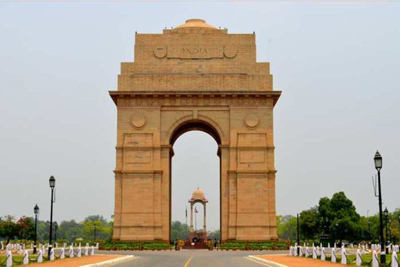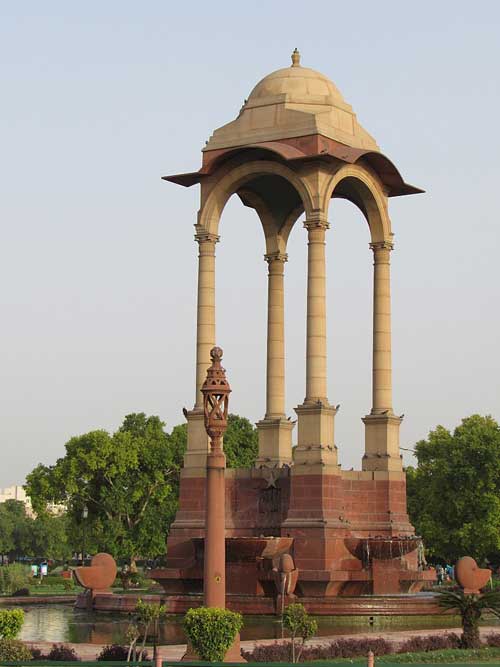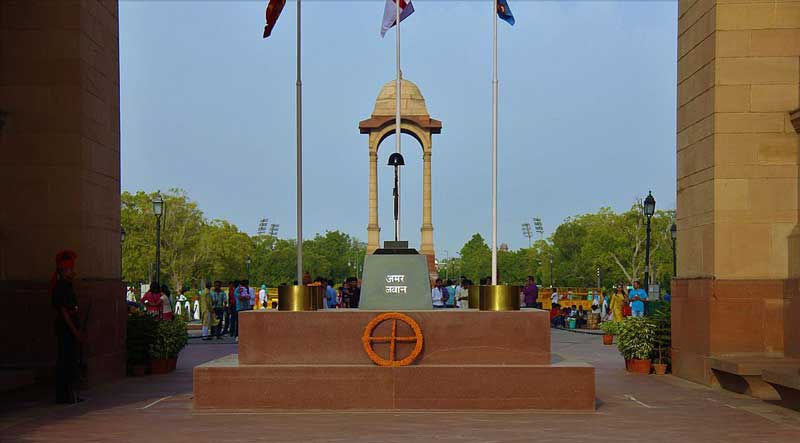
Located at the heart of India's capital city, New Delhi, about 2.3 km from the Rashtrapati Bhavan, the India Gate is a war memorial dedicated to honour the 82,000 soldiers of the Undivided Indian Army who lost their lives during World War I between 1914 and 1921 and the Third Anglo-Afghan War (1919). Originally named as All India War Memorial, the 42 m (about 138 feet) tall India Gate is one of many British monuments built by order of the Imperial War Graves Commission, later renamed Commonwealth War Graves Commission.
Initiated by the British Imperial Mandate in 1917, the foundation stone of the structure was laid in a military ceremony on 10 February 1921, at 4:30 PM, by the visiting Duke of Connaught, the third son of Queen Victoria, which was attended by members of the Indian Army as well as the Imperial Service Troops. The structure was designed by architect Sir Edwin Lutyens, an Englishman, who designed numerous other war memorials and was also the principal planner of New Delhi. Lutyens refused to incorporate pointed arches or other Asian motifs in his design, but strove instead for classical simplicity. In fact, the design almost looks like a triumphal arch, similar to the Arch de Triomphe in Paris in France. The project was completed ten years later in 1931, the year of the formal dedication of New Delhi as the capital of India and was inaugurated on February 12, 1931, by the Viceroy, Lord Irwin.



India Gate, official name Delhi Memorial, is primarily made of red and yellow sandstones sourced from Bharatpur. It stands on a low base and rises in asymmetrical steps crowned with a shallow dome at the top, which was intended to be filled with flaming oil on ceremonial occasions, which never materialized. The cornices of the dignified memorial are adorned with the inscription of the sun, which symbolized the British Imperial Colony and the word INDIA is inscribed at the top of the arches on both sides flanked by the dates 1914 (MCMXIV) on the left and 1919 (MCMXIX) on the right. The names of 13,218 war dead, including that of a female staff nurse from the Territorial Force are inscribed on the memorial. However, due to security reasons access to read the names on the memorial is restricted.

About 150 m east of the India Gate, a canopy was constructed in 1936, which once housed the statue of George V in his coronation robes. The statue was later removed and relocated to Coronation Park in 1960 and today, the empty canopy symbolizes the British retreat from India.
In the wake of Liberation of Bangladesh in December 1971, ‘Amar Jawan Jyoti’ or the flame of the immortal soldier was erected under the arch of the India Gate to commemorate the Indian soldiers killed in action. The small and simple structure, consisting of a black marble plinth with a reversed rifle, capped by a war helmet and bounded by four eternal flames, was built beneath the soaring Memorial Archway. It was inaugurated by the then Prime Minister Indira Gandhi on 26 January 1972, the 23rd Republic Day of India.

Every year on 26th January, the Prime Minister lays a floral wreath at the Amar Jawan Jyoti, followed by two minutes silence in the memory of the soldiers who lost their lives for the country in the freedom movement and the succeeding wars for the defense of sovereignty of their country. The Republic Day parade, which starts from the Presidential House, known as the Rashtapati Bhavan, also passes the Gate.

The India Gate, counted among the largest war memorials in India, is now a popular meeting place for the Deliites and a major tourist spot in Delhi. The large expanse of the lush green lawns around the imposing structure is considered as a popular picnic spot by the locals. After the end of the day the surrounding area dramatically changes with wonderful lighting, while the fountains nearby make a lovely display with coloured lights.